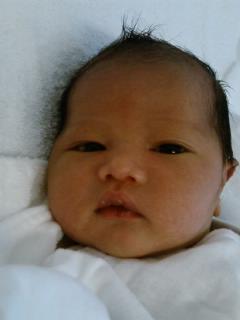Mulai malam semalam baby telah dimasukkan ke dalam ruang “UV light” atau “blue light therapy” kerana bacaan bilirubin melebihi 12 mg/dL iaitu 13.5 mg/dL. Kalau ikutkan sejarah perubatan anak2 kami, semua pernah “terkena” demam kuning. Cuma pada kali ini, kami tidak bersedia dengan ubat2an herba cina yang biasanya digunakan. Diharapkan bacaan bilirubin pada darah baby akan turun ke paras normal. Insyaallah. Pagi esok darah akan diambil untuk diuji.
Nama baby pun sudah hampir tetap cuma dalam proses “kesesuaian” mengikut pandangan pakar (yeke)…hehe..
Neonatal jaundice
From Wikipedia, the free encyclopedia
Neonatal jaundice is a yellowing of the skin and other tissues of a newborn infant. A bilirubin level of more than 5 mg/dL manifests clinical jaundice in neonates whereas in the adults 2 mg/dL would look icteric. In newborns jaundice is detected by blenching the skin with digital pressure so that it reveals underlying skin and subcutaneous tissue.
In neonates the dermal icterus is first noted in the face and as the bilirubin level rises proceeds caudal to the trunk and then to the extremities.
Infants whose jaundice is restricted to the face and part of the trunk above the umbilicus, all have the bilirubin less than 12 mg/dL. Infants whose palms and soles are yellow, have serum bilirubin level over 15 mg/dL.
In infants jaundice can be measured using invasive or non-invasive methods. In non invasive method Ingram icterometer and Transcutaneous bilirubinometer are used.
Treatment
Infants with neonatal jaundice are treated with colored light called phototherapy. Scientists randomly assigned 66 infants 35 weeks of gestation to receive phototherapy. After 15±5 the levels of bilirubin, a yellowish bile pigment that in excessive amounts causes jaundice, were decreased down to 0.27±0.25 mg/dl/h in the blue light. This shows that blue light therapy helps reduce high bilirubin levels that cause neonatal jaundice.
Exposing infants to high levels of colored light breaks down the bilirubin. Scientists studied 616 capillary blood samples from jaundiced newborn infants. These samples were randomly divided into three groups. One group contained 133 samples and would receive phototherapy with blue light. Another group contained 202 samples would receive room light, or white light. The final group contained 215 samples, and were left in a dark room. The total bilirubin levels were checked at 0, 2, 4, 6, 24, and 48 hours. There was a significant decrease in bilirubin in the first group exposed to phototherapy after two hours, but no change occurred in the white light and dark room group. After 6 hours, there was a significant change in bilirubin level in the white light group but not the dark room group. It took 48 hours to record a change in the dark room group’s bilirubin level. Phototherapy is the most effective way of breaking down a neonate’s bilirubin.
Phototherapy works through a process of isomerization (same molecule but with a different arrangement of the atoms) that changes the bilirubin into water-soluble isomers that can be passed without getting stuck in the liver.
In phototherapy, blue light is typically used because it is more effective at breaking down bilirubin (Amato, Inaebnit, 1991). Two matched groups of newborn infants with jaundice were exposed to intensive green or blue light phototherapy. The efficiency of the treatment was measured by the rate of decline of serum bilirubin, which in excessive amounts causes jaundice, concentration after 6, 12 and 24 hours of light exposure. A more rapid response was obtained using the blue lamps than the green lamps. However, a shorter phototherapy recovery period was noticed in babies exposed to the green lamps(1). Green light is not commonly used because exposure time must be longer to see dramatic results(1).
Light therapy may increase the risk of nevi, or skin moles, in childhood. Randomly, 36 nevi, or moles, received ultraviolet phototherapy. After exposure, the moles’ average size increased from 4.7 mm2 to 5.3 mm2. This was observed in 28 of the 36 moles. Going further, an autoradiograph proved that each mole had an increase in melanocytes, keratinocytes and dermal cells (all skin cells) in comparison with the unexposed nevi, which in turn also increased the risk of melanoma (skin cancer).
Increased feedings help move bilirubin through the neonate’s metabolic system.
Complications
Prolonged hyperbilirubinemia (severe jaundice) can result into chronic bilirubin encephalopathy (kernicterus). Quick and accurate treatment of neonatal jaundice helps to reduce the risk of neonates developing kernicterus.
An effect of kernicterus is a fever. A male full term neonate had hyperbilirubinemia (kernicterus) and jaundice at the age of 4 days old. He displayed symptoms of increased lethargy, refusal to eat, and had a fever. The neonate who was diagnosed with kernicterus displayed symptoms of a fever.
Another effect of kernicterus is seizures. The Neonatal Unit at Allied Hospital Faisalabad studied 200 neonates of either gender who presented seizures during their hospital stay from April 2003 to June 2004. The seizures were evaluated and one cause of the seizures was kernicterus. 4.5%, or 9 neonates, displayed seizures caused by kernicterus.
High pitched crying is an effect of kernicterus. Scientists used a computer to record and measure cranial nerves 8, 9 and 12 in 50 infants who were divided into two groups equally depending upon bilirubin concentrations. Of the 50 infants, 43 had tracings of high pitched crying.
Exchange transfusions performed to lower high bilirubin levels are an aggressive treatment.
p/s: setelah dua hari tidak berjumpa Mama, anak2 seronok pergi ke hospital tadi tetapi hanya boleh melihat baby dari luar cermin bilik bayi sahaja. Di sini bayi tidak boleh dibawa keluar dari bilik bayi dan berjumpa dengan orang lain kecuali ibu2 semasa menyusukan anak2 mereka






Recent Comments